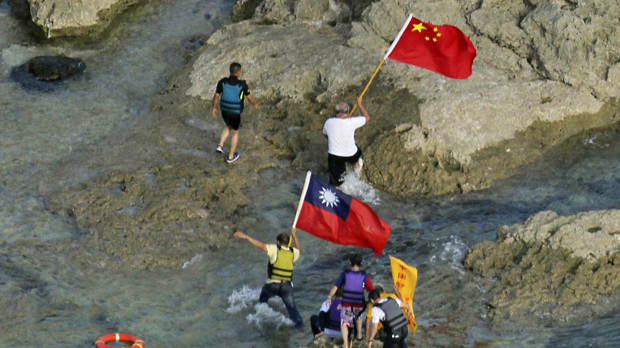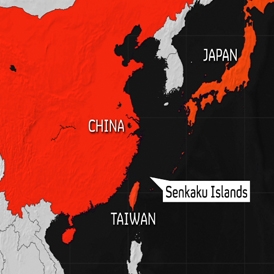China v Japan islands row – why should we care?
Japan and China are in dispute over rights to a group of uninhabited islands in the East China sea. Channel 4 News examines what is behind the flare-up and why the islands are so important.

Such disputes are likely to gain in significance in the coming years, especially since the US – the world’s only military superpower at present – has said that it is tilting its foreign policy objectives more towards this region.
With China the likely target for containment by the US, former imperial players such as Japan and Russia are unlikely to take a back seat as battles for the world’s natural and strategic resources and positions of power become more fierce.
The sovereignty of the eight islands, which are known to the Chinese as Diayou-Tai and to the Japanese as Senkaku-Shoto, is the subject of a long-simmering feud between the two states. They are currently administered by Japan.
Territorial sovereignty could prove extremely lucrative to China and unlock exclusive economic rights to nearly 20,000 square miles of undersea gas and oil reserves as well as rich fishing grounds.
Sovereignty has been fiercely contested in recent times since administration of the islands was transferred from the US to Japan in 1972. Claims over who is responsible for the islands cite evidence going back to the early 15th century, however.
Strictly speaking, the row is between Taiwan, China and Japan, although Taiwan is not officially recognised as a state by the UN, and is itself subject to a complex sovereignty claim by China.
Row
The latest flare-up appears to have been instigated by Tokyo’s right-wing governor, Shintaro Ishihara, who back in April 2012 said he was going to purchase three of the uninhabited islands on behalf of the Tokyo prefecture. Four of them, it is reported, have been privately owned by the same Japanese family for the past 40 years. At least one of the islands is under Tokyo’s jurisdiction.
The arrival of a group of Japanese activists on the islands in recent days, triggering huge protests in China, has inflamed a row which last blew up in 2010.
Then, Japan and China clashed over the ramming of a Japanese coastguard by a Chinese fishing trawler. Japan arrested the boat and crew, with the resulting tensions being played out on the streets in the form of massive protests in a number of Chinese cities.
After considerable political pressure, the crew and boat were released.
More recently, following the Japanese activists’ arrival, Japanese police arrested five Chinese activists who landed on the islands from Hong Kong, according to Chinese media reports.
Interestingly, the US is obliged to defend the islands on behalf of Japan, which had administered them since 1895, under the terms of the 1960 US-Japan Treaty of Mutual Cooperation and Security.

Japan and China: some other island disputes
The current row is part of a wider round of sabre-rattling, especially by China, made all the more significant because of China’s status as a rising global player. Beside their fight with each other over the Sunkaku/Diayou-Tai chain, China and Japan are involved in other local territorial disputes.
Along with Vietnam, Taiwan, Brunei, the Philippines and Malaysia, China has a small military presence on the Spratly islands which lie in the South China sea off Malaysia and the Philippines. These islands are believed to have untapped potential reserves of fossil fuels.
Tensions sporadically bubble up over these more than several hundred islands and islets which are within one of the world’s busiest shipping corridors. The Philippines has recently sent a warship to the area while in June, Vietnam staged military exercises.
China’s less powerful neighbours are simply alarmed at its increasingly bold stance internationally. In 1995, China even built structures on some of the islands in the group but China’s global status and wealth have since increased hugely, making its overtures in such disputes more significant.
Japan is also in dispute with Russia over the two most southerly islands of the Kuril archipelago which are administered by Russia. The origin of the dispute in various forms can be traced from the mid-19th century but the modern sovereignty row dates from the end of World War II.
The two countries still have not signed a peace treaty.
In the past, the European Union has called for the islands to be returned to Japan, much to Russia’s fury and in the last 18 months, Russia’s stance on defending its sovereignty claim has become more bullish with it announcing plans to deploy anti-air missiles on the islands.
-
Latest news
-
As India goes to the polls in the world’s largest election – what do British-Indians think?6m

-
Tees Valley: Meet the candidates in one of the biggest contests coming up in May’s local elections4m

-
Keir Starmer says public sector reform will be a struggle7m

-
Nicola Sturgeon’s husband Peter Murrell charged with embezzlement of funds from SNP1m

-
Ukraine might finally get $60billion in American weapons and assistance to defend against Russia3m

-




